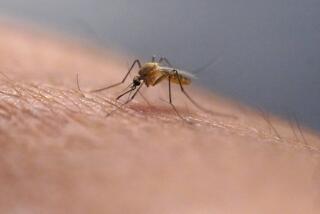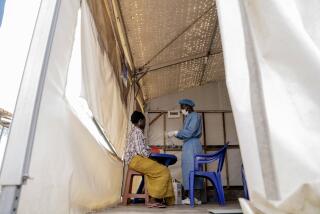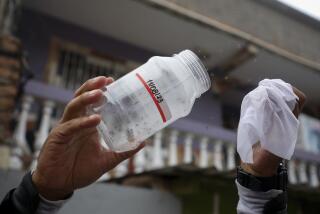A Grotesque Ailment Thrives on Latin American Poverty
COATEPEQUE, Guatemala — Maria Oloxon thought her son Cristian was out of the woods.
The 5-year-old’s fever was all but gone, his wiry black hair no longer drenched with sweat, and there was no trace of the crippling muscle pains that had left his tan body writhing in agony for eight days.
But then the blood began to run from his nose and ooze from his lips.
“We were noting that his color was much better and saying that he could go outside and play with his cousins,” said Oloxon, a 33-year-old mother of five. “Then we were screaming and praying, ‘Please God, save our little one!’ ”
Cristian, who was rushed to the hospital and eventually made a full recovery, had been stricken with a potentially fatal form of dengue fever--a painful, mosquito-borne virus characterized by headaches, rashes, cramps and severe back and bone pain.
Most dengue sufferers recover after about a week, but those stricken with hemorrhagic variety begin to bleed internally just when it appears they have recovered. The victims can die within a few days if they are not hospitalized.
Hemorrhagic dengue, which usually strikes children and the elderly because of their weaker immune systems, has killed at least 70 people in Latin America this year.
There is no cure for dengue, and medical experts aren’t sure how the hemorrhagic virus is structurally different from dengue’s nonfatal forms. Still, doctors can save those stricken with hemorrhagic dengue by treating its symptoms and replenishing the blood and plasma lost to internal bleeding--if the patients receive treatment in time.
A global pandemic of dengue began in Southeast Asia after World War II and began intensifying in 1982, according to the U.S. Centers for Disease Control and Prevention.
Not as aggressive as other highly contagious viruses, such as Ebola, it is spread by mosquitoes hatched in standing water--ponds, outdoor sinks, flowerpots or garbage piles behind many homes in Central and South America.
Houses without air-conditioning, whose screenless windows are almost always left open to vent stifling heat, become easy targets for the insects. They feed at night, while families sleep.
“One infected person can infect an entire neighborhood,” said Jorge Arias, Latin American advisor on communicable diseases for the Washington-based Pan American Health Organization. “Once a mosquito bites someone with dengue, it becomes very easy for that mosquito to give it to dozens of others.”
Another factor is ignorance. “Where we live, the air is infected,” said a man whose son barely survived dengue in a hospital and who cannot read the many hospital signs warning of mosquitoes. He blamed fear left over from Guatemala’s 36-year civil war. An evangelical minister said the disease “signifies that Jesus Christ is testing people.” Even hundreds of soldiers deployed from Guatemala City to mop up standing water couldn’t understand how a mosquito could carry a deadly disease.
More to Read
Sign up for Essential California
The most important California stories and recommendations in your inbox every morning.
You may occasionally receive promotional content from the Los Angeles Times.










